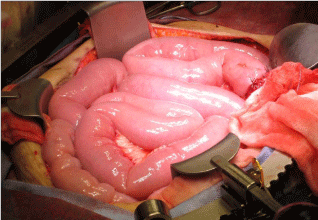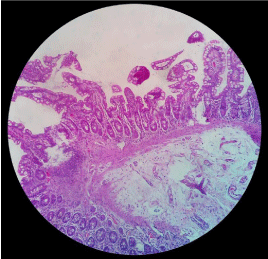
Research Article
J Stem Cell Res Transplant. 2015; 2(2): 1019.
The First Case of Intestinal Transplantation in the Philippines: Perspective from a Developing Country
Siegfredo R. Paloyo¹*, Ferri P David-Paloyo¹, Marc Paul J Lopez¹, Andrew D Dimacali² and Alfredo R Paloyo³
¹Department of Surgery, University of the Philippines- Philippine General Hospital, Philippines
²Department of Pathology, University of the Philippines- Philippine General Hospital, Philippines
³Centre for Human and Social Capital Research, University of Wollongong, Australia
*Corresponding author: Siegfredo R Paloyo, Department of Surgery, University of the Philippines- Philippine General Hospital, Manila, Philippines
Received: May 16, 2015; Accepted: September 15, 2015; Published: October 03, 2015
Abstract
Intestinal transplantation has been considered the last frontier of transplantation because of the high immunogenicity of the organ itself. Although it remains the least common transplant procedure performed in the United States comprising only 0.89% of total organ transplants from 1990 to 2013 (https://optn.transplant.hrsa.gov/), we have witnessed increasing number of intestinal transplant procedures over the last decade. Early attempts were hobbled by technical and immunologic complications that contributed to graft failure or death. In developing countries, because of financial constraints and lack of expertise, the procedure is rarely contemplated and the default treatment is still Total Parenteral Nutrition (TPN), despite its attendant complications such as cholestatic liver failure, infection and sepsis. Furthermore, in the Philippines, where most patients pay out-of-pocket for medical care, the cost of TPN can be prohibitive, which often traps them in a downward spiral of lost income and high health care costs.
Advances in surgical techniques and better immunosuppressive drugs contributing to improved graft and patient survival rates however have rendered intestinal transplantation as a viable option for patients with intestinal failure becoming cost-effective as compared to long-term TPN. We present a case where economic challenges associated with intestinal transplants were successfully overcome through creative post-operative care founded on evidence-based concepts. This was the first instance of an isolated intestinal transplantation in the Philippines with 1-year follow up.
Keywords: Intestinal transplant; Short bowel syndrome; Total parenteral nutrition
Case Report
A 44-year-oldfemale, blood type O-positive was admitted at the Philippine General Hospital for acute surgical abdomen. Upon exploration, an intussusceptions with resultant gangrene was noted over majority of the small intestine necessitating resection with subsequent formation of a 10 cm proximal jejunostomy and distal colostomy. Consequently, this patient developed short bowel syndrome despite our efforts to reefed the proximal output to the distal stoma. TPN was immediately started but due to its cost, it was erratically given. It soon became evident that her only chance of survival was an intestinal transplant [1,2].
Over the next 1 ½ months, with the available TPN, we were able to stabilize her weight to 37 kg (initial weight: 53 kg) and on day 50 after the first surgery, an organ was offered from a 20-year old male, blood type identical deceased donor with 3 HLA antigen match. The entire small intestine (jejunum and ileum) was procured in the course of a multi-organ retrieval. The recipient received rabbit anti-thymocyte globulin (rATG, Thymoglobulin at 1.5 g/kg) and methylprednisolone (Solumedrol) 1 gram IV as induction therapy prior to surgery. The small bowel graft was transplanted after a cold ischemia time of 10hours. The arterial an astomosis was reconstructed end-to-side (superior mesenteric artery to infrarenal aorta) while the venous an astomosis was performed systemically (superior mesenteric vein to inferior vena cava). After reperfusion, the graft exhibited homogenous perfusion and visible peristalsis (Figure 1). Intestinal reconstruction was done with the native proximal jejunum being sewn end-to-end with the graft jejunum and the ileum an astomosis end-to-side with the distal colon of the recipient, forming a chimney-type (Bishop- Koop) ileostomy over the right lower quadrant for surveillance biopsies. A tube jejunostomy was also performed for feeding purposes.The patient recovered uneventfully from the operation. Enteral nutrition was initiated within 48 hours via tube jejunostomy a rate of 30 ml/hr reaching the required caloric intake orally by the 10th postoperative day. Additional doses of Thymoglobulin were given on days 2, 4, 6, and 8 while rituximab (Rituxan) at 150 mg/m2 was given on day 3. Maintenance immune suppression consisted of tacrolimus (Program) with doses adjusted to reach a target trough of 10-15 mg/ ml and prednisone, which was given at tapering doses reaching 10 mg orally by day 10.

Figure 1: Intestinal graft after reperfusion.
Visual inspection of the distal stoma with weekly biopsies taken endoscopically from the graft was performed to monitor for rejection. Both the recipient and donor were Cytomegalovirus (CMV) IgGpositive, thus oral valganciclovir (Valcyte) was taken for 6 months. Fungal and Pneumocystis jiroveciprophylaxis were administered with fluconazole (Diflucanazole) and co-trimoxazole (Bactrim), respectively for a year. The patient was discharged on day 25 after transplant with excellent graft function. She remained rejection-free at 1-year follow-up with a present weight of76 kg (BMI 29.7) and significantly improved quality of life. Recent endoscopic histologic findings revealed chronic nonspecific inflammation with no apoptotic bodies, mucosal changes or vasculitis seen (Figure 2).

Figure 2: Intestinal graft biopsy 1 year after transplant (H & E stain).
Discussion
Intestinal transplantation has matured to be an accepted therapeutic option and the only chance of cure for patients with intestinal failure who fail parenteral nutrition. It is more difficult to transplant than other solid organs due to its strong expression of histocompatibility antigens, a large number of lymphoid tissue, and resident microorganism with acute rejection earning the moniker as “the Achilles’ heel of intestinal transplantation”. Aside from the acquiring better surgical techniques and the advent of novel immunosuppressive agents, aggressive graft surveillance protocols and new diagnostic and treatment modalities for Post-Transplant Lymph Proliferative Disease (PTLD) also contributed to more favorable outcomes.
This was the first experience of intestinal transplantation in the Philippines. Long-term patient and graft survival after intestinal transplantation, either as an isolated graft or part of a composite graft, continues to improve with a 1 and 5-year graft survival of 78.6% and 48%, respectively [3]. In the case described above, the patient received an isolated intestinal graft, which has kept her from TPN and with improved overall nutritional status.
Although intravenous delivery of the immunosuppressant Tacrolimus remains the preferred route of administration, it is not available locally due to monetary considerations. The Enteral form is associated with fewer adverse events, but it is poorly absorbed and endotracheal intubation in this case precluded its use. Sublingual delivery of the drug, which has been shown to be as effective as the IV route [4], allowed use of lower dosages (i.e. 1-3 mg per day) to achieve the desired therapeutic concentrations of 10-15ng/ml. In addition, Tacrolimus was intentionally co-administered with grapefruit juice (200 ml) in this patient. Due to the drug’s narrow therapeutic range, its consumption is usually discouraged in post-transplant patients as it increases plasma concentrations [5,6] through the inhibition of CYP3A-enzymes. The simultaneous intake thus allowed a means of further decreasing the dosages while still meeting therapeutic targets and avoiding rejection.
Therapeutic advances ideally should not simply be confined to the regions with better means to implement them. But given the lack of resources, patients in less developed countries continue to have fewer alternatives available to them. While accepting these limitations, the adaptation of innovative techniques to a fairly advanced procedure such as intestinal transplant has allowed us to affirm its applicability in less than exemplary settings, and with economic considerations notwithstanding.
References
- Deshpande K. Total Parenteral Nutrition and Infections Associated With Use of Central Venous Catheters. American Journal of Critical Care. 2003; 12: 326-327.
- Troppmann C, Gruessner R. Intestinal transplantation in Surgical Treatment. Holzheimer RG, Mannick JA editors. Evidence-Based and Problem-Oriented. Munich: Zuckschwerdt. 2001.
- Smith J, Skeans M, Horslen S, Edwards E, Harper A, Snyder J, et al. OPTN/SRTR 2013 Annual Data Report: Intestine. Am J Transplant. 2015; 15: 1-16.
- Collin C, Boussaud V, Lefeuvre S, Amrein C, Glouzman AS, Havard L, et al. Sublingual Tacrolimus as an Alternative to Intravenous Route in Patients With Thoracic Transplant: A Retrospective Study, Transplantation Proceedings. 2010; 42: 4331-4337.
- Peynaud D, Charpiat B, Vial T, Gallavardin M, Ducerf C. Tacrolimus severe over dosage after intake of masked grapefruit in orange marmalade. European Journal of Clinical Pharmacology. 2007; 63: 721-722.
- Fukatsu S, Fukudo M, Masuda S, Yano I, Katsura T, Ogura Y, et al. Delayed Effect of Grapefruit Juice on Pharmacokinetics and Pharmacodynamics of Tacrolimus in a Living-Donor Liver Transplant Recipient. Drug Metabolism and Pharmacokinetics. 2006; 21: 122-125.